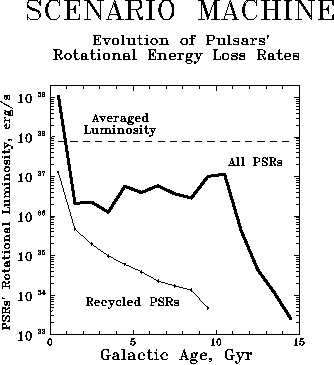Next: Population Synthesis of X-ray Up: Cosmic Rays and Evolution Previous: Supernova Explosions
![]()
![]()
![]()
![]()
![]()
Next: Population
Synthesis of X-ray Up: Cosmic
Rays and Evolution Previous: Supernova
Explosions
Immediately after the discovery of pulsars, especially of the Crab pulsar, it became clear that rapidly rotating NS are copious sources of relativistic particles. Unfortunately, up to now (a period of 25 years) it has remained unclear what the fraction of the total energy carried away by the relativistic particles is and what their spectrum looks like. Nevertheless, it appears fairly safe to suppose that the generation rate of CR a pulsar is simply proportional to the magnetorotational energy losses of the pulsar:

The rotational energy of a pulsar is initially stored as a result of either gravitational energy release of the collapsing star (this is valid for most pulsars), or accretion spin-up (for recycled pulsars).

Figure 37: Evolution of magnetorotational energy of NS in elliptical
and spiral galaxies.
In fact, from the point of view of global galactic energetics, pulsars transform the rotational energy into energy of relativistic particles, which in turn results from gravitational energy release during stellar collapse, thus closing the loop and maintaining the observed energy equipartition between different constituents of the Galaxy.
Figure 37 shows the evolution of
magnetorotational energy released by ejecting NS in elliptical
and spiral galaxies taken from the Scenario Machine
calculations. As seen from this figure, ejecting NS may contribute as high
as 1 percent to the required CR energy per galaxy (![]()
![]() erg s
erg s![]() )
only at early stages of galaxy evolution, with average contribution per
a typical spiral galaxy being two order of magnitude less.
)
only at early stages of galaxy evolution, with average contribution per
a typical spiral galaxy being two order of magnitude less.